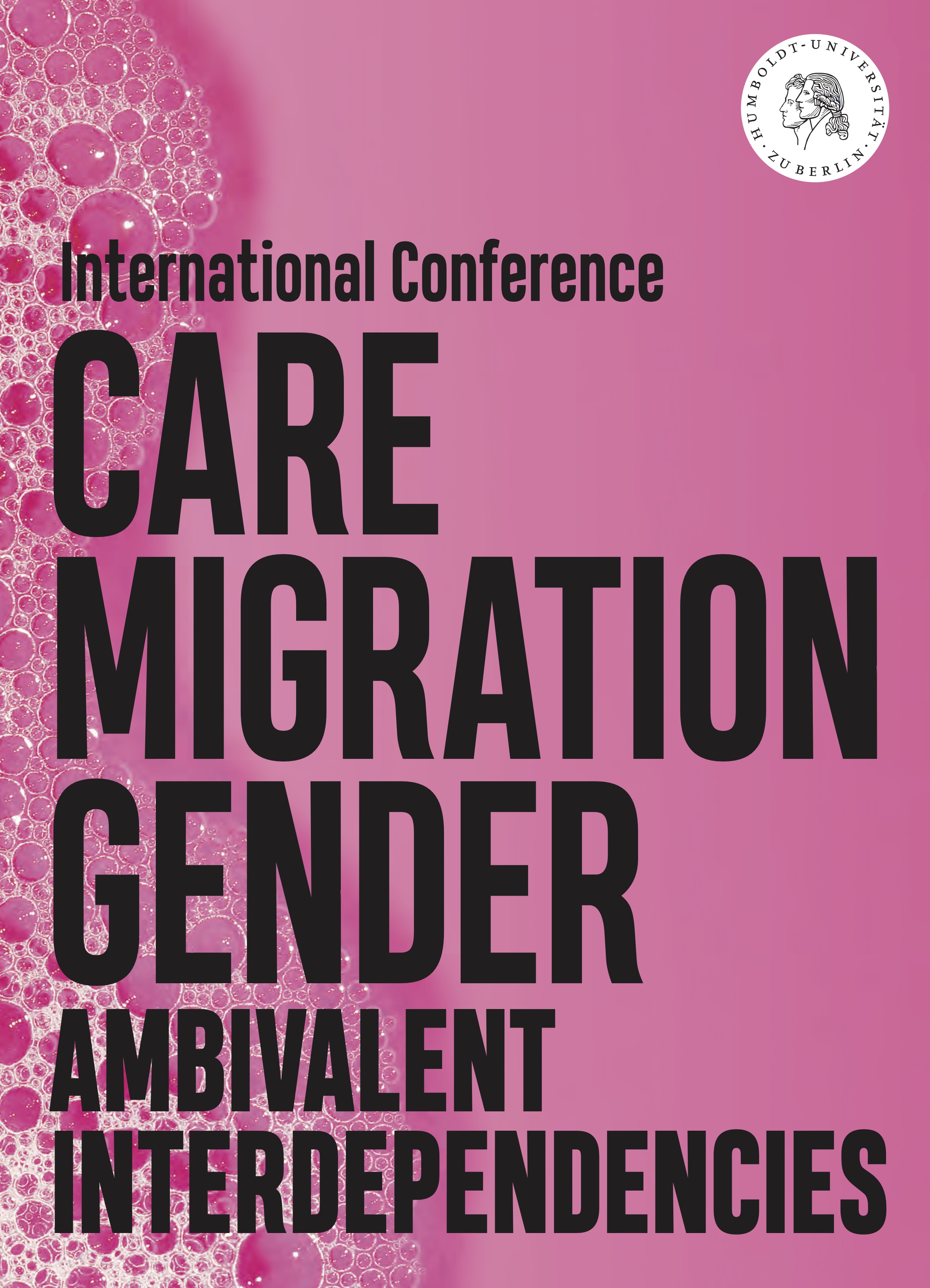"… I Care Because You Do". Towards a cinema of care | Für ein Sorge tragendes Kino
DOI:
https://doi.org/10.17169/ogj.2022.158Schlagworte:
Film, Geschlecht, Migration, Race, SorgeAbstract
Das Kino wurde vielfach als Ort beschrieben, an dem man* sich selbst durch die Augen eine*r anderen sehen kann. Es ist auch der Ort, an dem man* ganz bei sich ist und doch den befremdlichsten und furchterregendsten Dingen ausgesetzt sein kann. Grundlegende Trennungen und Teilungen wie diese dienen dem vorliegenden Text als Ausgangspunkte, um Spekulationen darüber zu entwickeln, wie differentielle Alterität und care für die Re-Vision eines Kinos fruchtbar gemacht werden könnten, das nicht didaktisch oder aufklärerisch ist, und sicherlich auch nicht kathartisch. Kein Kino, das zerstreut. Sondern eines, dessen Sinn im alltäglichen Sorgetragen besteht, ohne utilitaristisch zu sein. Es soll ein cinema of care sein, dem es eher darum geht, gemacht zu werden als darum, von einem möglichst großen Publikum gesehen zu werden. Eher als Ort für ein Medium soll es der Anordnung eines Remediums entsprechen.
Literaturhinweise
Angerer, Marie-Luise/Gramlich, Naomie (Hg.) (2020): Feministisches Spekulieren. Genealogien, Narrationen, Zeitlichkeiten. Berlin: Kulturverlag Kadmos.
Bekolo, Jean-Pierre (2017a): J‘ai envie de faire des films qui soignent, entretien rédigé par Simon Mbaki Mazakala (21.06.2017). http://africine.org/entretien/jean-pierre-bekolo-jai-envie-de-faire-des-films-qui-soignent/14158 (06.08.2020).
Bekolo, Jean-Pierre (2017b): Pour un projet cinématographic africain/An African Cinematographic project (08.03.2017). https://bekolopress.wordpress.com/2017/03/ (06.08.2020).
Best, Stephen M. (2004): The Fugitive’s Properties. Law and the Poetics of Dispossession. Chicago, IL; London: The University of Chicago Press.
Bonitzer, Pascal (1976): Des hors-champs. In: Ders.: Le regard et la voix. Essais sur le cinema. Paris: Union Générale d’Éditions, 9–24.
Bonitzer, Pascal (1971/72): Hors-champ (un espace en défaut). In: Cahier du cinéma (234–235) (décembre 1971/janvier-février 1972), 15–26.
Carby, Hazel V. (1985): „On the Threshold of Woman’s Era“. Lynching, Empire, and Sexuality in Black Feminist Theory. In: Critical Inquiry 12 (1), „Race“, Writing, and Difference (Autumn 1985), 262–277. doi: https://doi.org/10.1086/448329
Chion, Michel (2011): Ton und Bild – eine Relation? Hypothesen über das Audio-Divisuelle. In: Butte, Maren/Brandt, Sabina (Hg.): Bild und Stimme. München: Wilhelm Fink, 49–66. doi: https://doi.org/10.30965/9783846751718_005
Chion, Michel (1985): Le son au cinéma. Paris: Editions de l‘Etoile/Cahiers du Cinéma.
Courtney, Susan (2005): Hollywood Fantasies of Miscegenation. Spectacular Narratives of Gender and Race, 1903–1967. Princeton, NJ; Oxford: Princeton University Press.
Deleuze, Gilles (1997a): Das Bewegungs-Bild. Kino 1 [Cinéma 1. L’image-mouvement. 1983]. Frankfurt am Main: Suhrkamp.
Deleuze, Gilles (1997b): Das Zeit-Bild. Kino 2 [Cinéma 2. L’image-temps. 1985]. Frankfurt am Main: Suhrkamp.
Deleuze, Gilles (2000): Die Literatur und das Leben. In: Ders.: Kritik und Klinik [Critique et clinique. 1993]. Frankfurt am Main: Suhrkamp, 11–17.
Deleuze, Gilles/Guattari, Félix (1975): Kafka. Für eine kleine Literatur (2019). Frankfurt am Main: Suhrkamp.
Derrida, Jacques (1972): La différance. In: Ders.: Marges de la philosophie. Paris: Éditions de minuit.
Denzin, Norman K. (2008): Die Geburt der Kinogesellschaft. In: Winter, Rainer/Niederer, Elisabeth (Hg.): Ethnographie, Kino und Interpretation. Die performative Wende der Sozialwissenschaften. Der Norman K. Denzin-Reader. Bielefeld: transcript, 89–136. doi: https://doi.org/10.1515/9783839409039-003
Doane, Mary Ann (2002): The Emergence of Cinematic Time. Cambridge, MA: Harvard University Press. doi: https://doi.org/10.2307/j.ctv1pnc1jq
Du Bois, W.E.B. (1903): Die Seelen der Schwarzen – The Souls of Black Folk (2003). Freiburg: Orange Press.
Espinosa, Julio Garcia (1969): Por un cine imperfect. Madrid: Castellote Ed.
Fanon, Frantz (1980): Schwarze Haut, weiße Masken. Übersetzt von Eva Moldenhauer. Frankfurt am Main: Syndikat.
Fanon, Frantz (1952): Peau noire, masques blancs (2012). Paris: Editions du Seuil. doi: https://doi.org/10.1522/030294726
Faye, Marc/Vignaux, Valérie (2009): Marius Rossillon (1867–1946) dit O’Galop. In: 1895. Mille huit cent quatre-vingt-quinze. Revue de l’association française de recherche sur l’histoire du cinéma, 59. doi: https://doi.org/10.4000/1895.3940
Gass, Lars Henrik (2017): Film und Kunst nach dem Kino. Köln: StrzeleckiBooks.
Gaines, Jane M. (2013): What Happened to the Philosophy of Film History. In: Film History 25 (1–2), 70–80. doi: https://doi.org/10.2979/filmhistory.25.1-2.70
Gaines, Jane M. (2001): Fire and Desire: Mixed-Race Movies in the Silent Era. Chicago & London: The University of Chicago Press. doi: https://doi.org/10.7208/chicago/9780226278735.001.0001
Guattari, Félix (1989): Les trois écologies. Paris: Galilée.
Gunning, Tom (1991): D.W. Griffith and the Origins of American Narrative Film. Champaign, IL: University of Illinois Press.
Gunning, Tom (1986): The Cinema of Attractions. Early Film, Its Spectator and the Avant-Garde. In: Wide Angel 8 (3/4), 63–70.
Hagener, Malte (2011): Das Medium in der Krise. Der Film, das Kinematografische und der Wert von instabilem Wissen. In: Augenblick. Marburger Hefte zur Medienwissenschaft 52, Positionen und Perspektiven der Filmwissenschaft, 30–46.
Haraway, Donna (2016): Staying with the Trouble. Making Kin in the Chthulucene. Durham, NC: Duke University Press. doi: https://doi.org/10.2307/j.ctv11cw25q
Johnson, Claire (1976): Women’s Cinema as Counter-Cinema [erstmals publiziert in Screen-Pamphlet Nr. 2, London 1973]. In: Nichols, Bill (Hg.): Movies and Methods. Vol 1, Berkeley, CA: University of California Press, 208–217.
Kaplan, E. Ann (1997): Looking for the Other. Feminism, Film, and the Imperial Gaze. London: Routledge.
Keeling, Kara (2003): „In the Interval“. Frantz Fanon and the „Problems“ of Visual Representation. In: Qui Parle 13 (2). doi: https://doi.org/10.1215/quiparle.13.2.91
Kuster, Brigitta (2018): Grenze filmen. Eine kulturwissenschaftliche Analyse audiovisueller Produktionen an den Grenzen Europas. Bielefeld: transcript. doi: https://doi.org/10.1515/9783839439814
Kuster, Brigitta (2014): Parler film. In: Tobias Hering (Hg.): Der Standpunkt der Aufnahme-Point of View. Berlin: Archive Books & Arsenal-Institut für Film und Videokunst, 228–243.
Kuster, Brigitta (in Vorbereitung): Die Location of Identity.
McClintock, Anne (1995): Imperial Leather. Race, Gender, and Sexuality in the Colonial Conquest. London: Routledge.
MacKenzie, Scott (2014): Film Manifestos and Global Cinema Cultures. A Critical Anthology. Berkeley, CA; London: University of California Press. doi: https://doi.org/10.1525/9780520957411
Marson, Una (1937): Cinema Eyes. In: Donnell, Alison (Hg.): Una Marson: Selected Poems (2011). Leeds: Peepal Tree Press, 139–141 (Gedicht erstmals publiziert 1937 in der Sammlung „The Moth and the Star“, published by the author, Kingston, Jamaika, B.W.J., 87–88).
Mayne, Judith (1990): The Woman at the Keyhole. Bloomington, In: Indiana University Press.
Mennel, Birgit/Nowotny, Stefan (2014): Die militante Ethik der Precarias a la deriva. Eine Einleitung. In: Precarias a la deriva: Was ist ein Streik? Militante Streifzüge durch die Kreisläufe der Prekarität. Vienna, Linz: transversal texts, 9–32.
Metz, Christian (1973): Sprache und Film [Langage et Cinéma (1971)]. Frankfurt am Main: Athenäum Verlag.
Metz, Christian (1972): Semiologie des Films. München: Wilhelm Fink.
Minh-ha, Trinh T. (1999): Cinema-Interval. London, New York: Routledge.
Mirzoeff, Nicholas (2011): The Right to Look. In: Critical Inquiry 37 (3), 473–496. doi: https://doi.org/10.1086/659354
Moten, Fred (2015): Blackness and Nonperformance, Vortrag im Rahmen von Afterlives: The Persistence of Performance, MoMa. https://www.youtube.com/watch?v=G2leiFByIIg (06.08.2020).
Moten, Fred (2013): Blackness and Nothingness (Mysticism in the Flesh). In: South Atlantic Quarterly 112 (4), 737–780. doi: https://doi.org/10.1215/00382876-2345261
Moten, Fred (2008): The Case of Blackness. In: Criticism 50 (2). Detroit, MI: Wayne State University Press. 177–218. doi: https://doi.org/10.1353/crt.0.0062
Mulvey, Laura (2016): Visuelle Lust und narratives Kino (1975). In: Peters, Kathrin/Seier, Andrea (Hg.): Gender & Medien-Reader. Zürich, Berlin: diaphanes, 45–60.
Mudimbe, Valentin Yves (1994): The Idea of Africa. Bloomington, IN: Indiana University Press.
Nyampeta, Christian/Engqvist, Jonatan Habib (2018): How to Rest Together. A Conversation. In: On Curating 36. https://www.on-curating.org/issue-36-reader/how-to-rest-together.html#.XwXWvPLgrxU (06.08.2020).
Pérez, Marta/Salvini Ramas, Francesco (2019): The Right to Care: Entering Outside in the Southern European Crisis of Welfare. http://www.ephemerajournal.org/contribution/right-care-entering-outside-southern-european-crisis-welfare (06.08.2020).
Rony, Fatimah Tobing (1996): The Third Eye. Race, Cinema, and Ethnographic Spectacle. Durham, NC: Duke University Press. doi: https://doi.org/10.1515/9780822398721
Schlüpmann, Heide (1992): Die Geburt des Kinos aus dem Geist des Lachens. In: Frauen und Film 53, 86–93.
Snead, James (1984): On Repetition in Black Culture. In: Henry Louis Gates, Jr. (Hg.): Black Literature and Literary Theory, New York: Methuen, 59–79.
Stewart, Jacqueline Najuma (2005): Migrating to the Movies. Cinema and Black Urban Modernity. Berkeley, CA: University of California Press. doi: https://doi.org/10.1525/9780520936409
Sullivan, Nikki (2012): The somatechnics of perception and the matter of the non/human: A critical response to the new materialism. In: European Journal of Women’s Studies, 19 (3), 299–313. doi: https://doi.org/10.1177/1350506812443477
The Care Collective (2020): Care Manifesto. The Politics of Interdependence. Verso Pamphlets series. London, New York: Verso Books.
Ukeles, Mierle Laderman (1971): Manifesto for Maintenance Art 1969! Proposal for an Exhibition „CARE“. https://web.archive.org/web/20120831223021/http://www.feldmangallery.com/media/pdfs/Ukeles_MANIFESTO.pdf (06.08.2020).
Waßmuth, Inken Gesine: Afrikaner als Produkt kolonisatorischen Sprechens in Kolonie und Heimat. In: Warnke, Ingo H. (Hg.): Deutsche Sprache und Kolonialismus (2009). Berlin, New York: Walter de Gruyter, 315–345.
Wilderson III, Frank B (2010): Red, White & Black. Cinema and the Structure of U.S. Antagonisms. Durham, NC & London: Duke University Press. doi: https://doi.org/10.1515/9780822391715
Williams, Linda (2006): Of Kisses and Ellipses. The Long Adolescence of American Movies. In: Critical Inquiry 32 (2), 288–340. doi: https://doi.org/10.1086/500705
Zimmer, Catherine (2015): Surveillance Cinema. New York: New York University Press.

Downloads
Zusätzliche Dateien
Veröffentlicht
Versionen
- 2023-08-04 (2)
- 2022-01-10 (1)
Zitationsvorschlag
Ausgabe
Rubrik
Kategorien
Lizenz
Copyright (c) 2022 Brigitta Kuster

Dieses Werk steht unter der Lizenz Creative Commons Namensnennung 4.0 International.
Alle Beiträge in Open Gender Journal erscheinen unter der Lizenz Creative Commons Namensnennung 4.0 International (CC BY 4.0). Die entsprechenden Texte dürfen Sie unter den Bedingungen der Lizenz frei nutzen (Lizenzvertrag, allgemeinverständliche Fassung). Es findet keine exklusive Übertragung von Verwertungsrechten („copyright transfer“) an die Zeitschrift statt. Open Gender Journal stellt den Autor*innen keinerlei Kosten für die Publikation (sogenannte Article Processing Charges, APC) oder die Einreichung (sog. Submission Charges) in Rechnung. Die Autor_innen werden ermutigt, ihre Beiträge auch an anderen Orten, z.B. in Repositorien, einzustellen.












